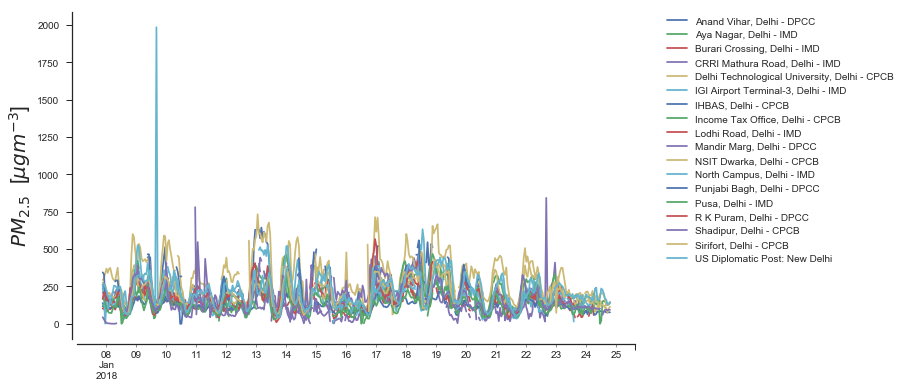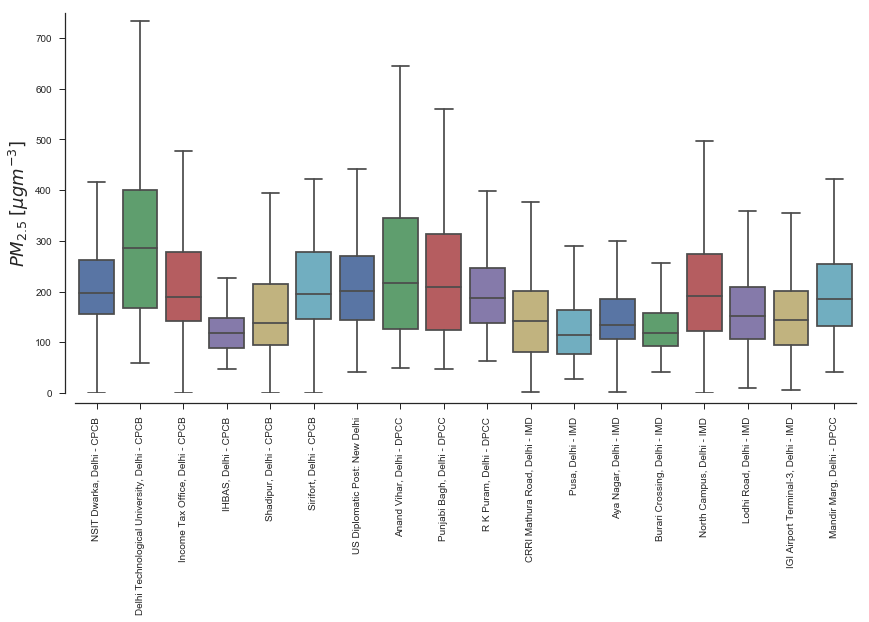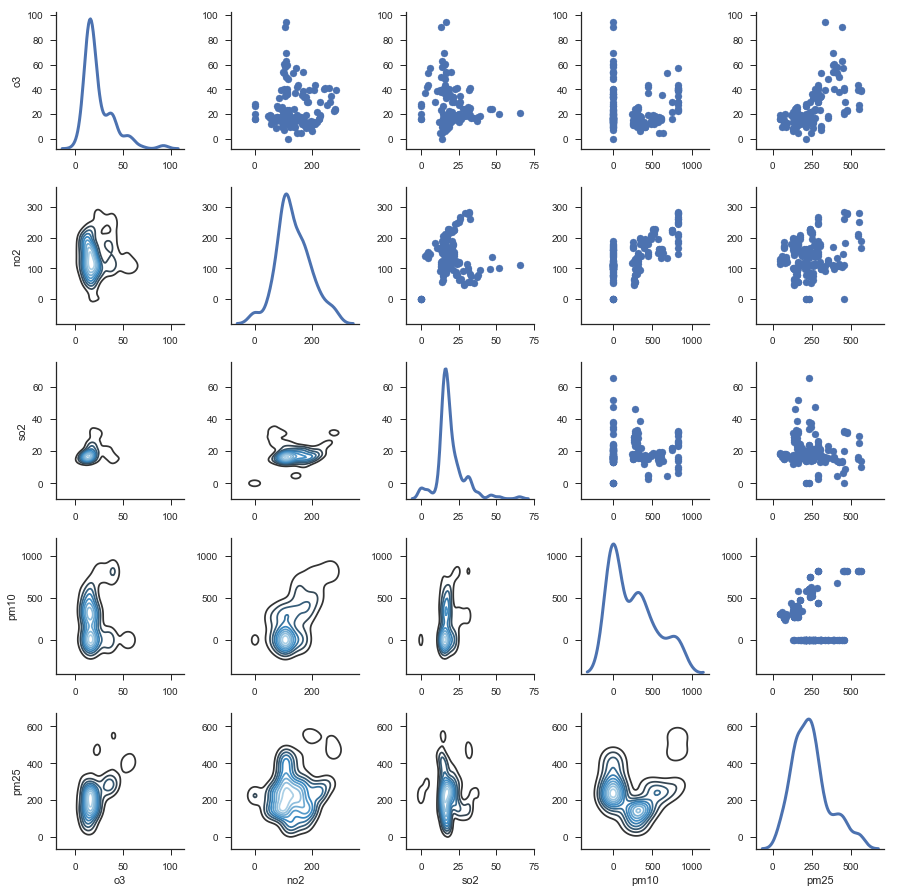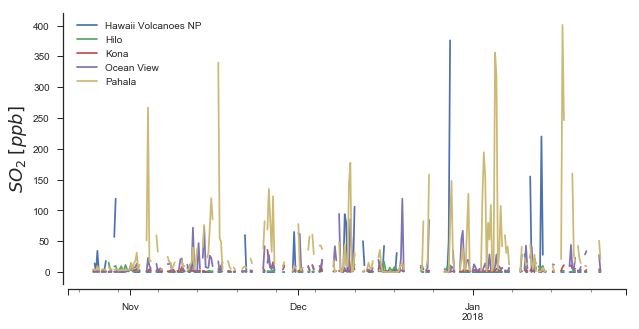Using the OpenAQ API¶
The openaq api is an easy-to-use wrapper built around the OpenAQ
Api. Complete API documentation can be
found on their website.
There are no keys or rate limits (as of March 2017), so working with the
API is straight forward. If building a website or app, you may want to
just use the python wrapper and interact with the data in json format.
However, the rest of this tutorial will assume you are interested in
analyzing the data. To get more out of it, I recommend installing
seaborn for manipulating the asthetics of plots, and working with
data as DataFrames using pandas. For more information on these,
check out the installation section of this documentation.
From this point forward, I assume you have at least a basic knowledge of python and matplotlib. This documentation was built using the following versions of all packages:
import pandas as pd
import seaborn as sns
import matplotlib as mpl
import matplotlib.pyplot as plt
import openaq
import warnings
warnings.simplefilter('ignore')
%matplotlib inline
# Set major seaborn asthetics
sns.set("notebook", style='ticks', font_scale=1.0)
# Increase the quality of inline plots
mpl.rcParams['figure.dpi']= 500
print ("pandas v{}".format(pd.__version__))
print ("matplotlib v{}".format(mpl.__version__))
print ("seaborn v{}".format(sns.__version__))
print ("openaq v{}".format(openaq.__version__))
pandas v0.21.0
matplotlib v2.1.0
seaborn v0.8.1
openaq v1.1.0
OpenAQ API¶
The OpenAQ APi has only eight endpoints that we are interested in:
- cities: provides a simple listing of cities within the platforms
- countries: provides a simple listing of countries within the platform
- fetches: providing data about individual fetch operations that are used to populate data in the platform
- latest: provides the latest value of each available parameter for every location in the system
- locations: provides a list of measurement locations and their meta data
- measurements: provides data about individual measurements
- parameters: provides a simple listing of parameters within the platform
- sources: provides a list of data sources
For detailed documentation about each one in the context of this API wrapper, please check out the API documentation.
Your First Request¶
Real quick, let’s go ahead and initiate an instance of the
openaq.OpenAQ class so we can begin looking at data:
api = openaq.OpenAQ()
Cities¶
The cities API endpoint lists the cities available within the platform. Results can be subselected by country and paginated to retrieve all results in the database. Let’s start by performing a basic query with an increased limit (so we can get all of them) and return it as a DataFrame:
resp = api.cities(df=True, limit=10000)
# display the first 10 rows
resp.info()
<class 'pandas.core.frame.DataFrame'>
RangeIndex: 2020 entries, 0 to 2019
Data columns (total 4 columns):
city 2020 non-null object
count 2020 non-null int64
country 2020 non-null object
locations 2020 non-null int64
dtypes: int64(2), object(2)
memory usage: 63.2+ KB
So we retrieved 1400+ entries from the database. We can then take a look at them:
print (resp.head(10))
city count country locations
0 Escaldes-Engordany 13324 AD 2
1 unused 314 AD 1
2 Abu Dhabi 477 AE 1
3 Buenos Aires 14976 AR 4
4 Amt der K�rntner Landesregierung 104663 AT 16
5 Austria 121987 AT 174
6 Amt der Ober�sterreichischen Landesregierung 154329 AT 16
7 Amt der Burgenl�ndischen Landesregierung 35608 AT 3
8 Amt der Salzburger Landesregierung 94197 AT 12
9 Amt der Burgenländischen Landesregierung 471 AT 1
Let’s try to find out which ones are in India:
print (resp.query("country == 'IN'"))
city count country locations
841 Mumbai 309477 IN 3
842 Kota 23264 IN 2
843 Delhi 1140259 IN 35
844 Ghaziabad 99087 IN 2
845 Barddhaman 2470 IN 3
846 Asansol 1590 IN 2
847 Lucknow 271912 IN 5
848 Muzaffarpur 116841 IN 1
849 Hyderabad 465962 IN 15
850 Visakhapatnam 208237 IN 8
851 Amritsar 77849 IN 1
852 Bhiwadi 20846 IN 1
853 Kolkata 168542 IN 7
854 Bengaluru 371649 IN 8
855 Howrah 50263 IN 4
856 Navi Mumbai 7725 IN 1
857 Ahmedabad 57714 IN 2
858 Faridabad 113546 IN 2
859 Nashik 76217 IN 4
860 Haldia 115284 IN 2
861 Thiruvananthapuram 46124 IN 2
862 Rohtak 95050 IN 1
863 Medak 2671 IN 1
864 Pune 145450 IN 1
865 Tirupati 159117 IN 4
866 Ajmer 25266 IN 2
867 Vijayawara 34902 IN 1
868 Durgapur 78761 IN 2
869 Jorapokhar 35558 IN 1
870 NOIDA 12061 IN 1
.. ... ... ... ...
873 Gaya 76810 IN 1
874 Chandrapur 232244 IN 2
875 Chennai 290415 IN 4
876 Siliguri 30 IN 2
877 Thane 130025 IN 3
878 Nagpur 72328 IN 5
879 Mandideep 7847 IN 1
880 Patna 75338 IN 1
881 Dhanbad 3 IN 1
882 Aurangabad 113529 IN 1
883 Kanpur 159678 IN 2
884 Moradabad 24595 IN 1
885 Chittoor 2013 IN 1
886 Alwar 14017 IN 1
887 Vijayawada 11624 IN 2
888 Udaipur 25699 IN 1
889 Jaipur 190441 IN 6
890 Ludhiana 72308 IN 1
891 Varanasi 181673 IN 1
892 Pali 23627 IN 2
893 Ujjain 16924 IN 1
894 Singrauli 14636 IN 1
895 Jodhpur 151172 IN 1
896 Agra 84301 IN 1
897 Dewas 11671 IN 1
898 Amaravati 11432 IN 1
899 Mandi Gobindgarh 48579 IN 1
900 Solapur 253940 IN 1
901 Pithampur 12173 IN 1
902 Gurgaon 147910 IN 1
[62 rows x 4 columns]
Great! For the rest of the tutorial, we are going to focus on Delhi, India. Why? Well..because there are over 500,000 data points and my personal research is primarily in India. We will also take a look at some \(SO_2\) data from Hawai’i later on (another great research locale).
Countries¶
Similar to the cities endpoint, the countries endpoint lists the
countries available. The only parameters we have to play with are the
limit and page number. If we want to grab them all, we can just up the
limit to the maximum (10000).
res = api.countries(limit=10000, df=True)
print (res.head())
cities code count locations name
0 2 AD 13638 3 Andorra
1 1 AR 14976 4 Argentina
2 18 AU 3248142 99 Australia
3 16 AT 1521351 306 Austria
4 1 BH 13820 1 Bahrain
Fetches¶
If you are interested in getting information pertaining to the
individual data fetch operations, go ahead and use this endpoint. Most
people won’t need to use this. This API method does not allow the df
parameter; if you would like it to be added, drop me a message.
Otherwise, here is how you can access the json-formatted data:
status, resp = api.fetches(limit=1)
# Print out the meta info
resp['meta']
{'found': 92506,
'license': 'CC BY 4.0',
'limit': 1,
'name': 'openaq-api',
'page': 1,
'pages': 92506,
'website': 'https://docs.openaq.org/'}
Parameters¶
The parameters endpoint will provide a listing off all the
parameters available:
res = api.parameters(df=True)
print (res)
description id name 0 Black Carbon bc BC
1 Carbon Monoxide co CO
2 Nitrogen Dioxide no2 NO2
3 Ozone o3 O3
4 Particulate matter less than 10 micrometers in... pm10 PM10
5 Particulate matter less than 2.5 micrometers i... pm25 PM2.5
6 Sulfur Dioxide so2 SO2
preferredUnit
0 µg/m³
1 ppm
2 ppm
3 ppm
4 µg/m³
5 µg/m³
6 ppm
Sources¶
The sources endpoint will provide a list of the sources where the
raw data came from.
res = api.sources(df=True)
# Print out the first one
res.ix[0]
active True
adapter arpalazio
city NaN
contacts [info@openaq.org]
country IT
description Air quality data from Lazio region, Italy
location NaN
name ARPALAZIO
organization NaN
region Lazio
resolution NaN
sourceURL http://www.arpalazio.net/
timezone NaN
url http://www.arpalazio.net/main/aria/sci/annoinc...
Name: 0, dtype: object
Locations¶
The locations endpoint will return the list of measurement locations
and their meta data. We can do quite a bit of querying with this one:
Let’s see what the data looks like:
res = api.locations(df=True)
res.info()
<class 'pandas.core.frame.DataFrame'>
RangeIndex: 100 entries, 0 to 99
Data columns (total 11 columns):
city 100 non-null object
coordinates.latitude 100 non-null float64
coordinates.longitude 100 non-null float64
count 100 non-null int64
country 100 non-null object
firstUpdated 100 non-null datetime64[ns]
lastUpdated 100 non-null datetime64[ns]
location 100 non-null object
parameters 100 non-null object
sourceName 100 non-null object
sourceNames 100 non-null object
dtypes: datetime64[ns](2), float64(2), int64(1), object(6)
memory usage: 8.7+ KB
# print out the first one
res.ix[0]
city Ulaanbaatar
coordinates.latitude 47.9329
coordinates.longitude 106.921
count 294682
country MN
firstUpdated 2015-09-01 00:00:00
lastUpdated 2018-01-24 13:15:00
location 100 ail
parameters [pm10, no2, so2, o3, co]
sourceName Agaar.mn
sourceNames [Agaar.mn]
Name: 0, dtype: object
What if we just want to grab the locations in Delhi?
res = api.locations(city='Delhi', df=True)
res.ix[0]
city Delhi
coordinates.latitude 28.6508
coordinates.longitude 77.3152
count 102326
country IN
distance 6.32199e+06
firstUpdated 2015-06-29 14:30:00
lastUpdated 2017-11-28 10:15:00
location Anand Vihar
parameters [pm10, pm25, so2, o3, co, no2]
sourceName CPCB
sourceNames [Anand Vihar, CPCB]
Name: 0, dtype: object
What about just figuring out which locations in Delhi have \(PM_{2.5}\) data?
res = api.locations(city='Delhi', parameter='pm25', df=True)
res.ix[0]
city Delhi
coordinates.latitude 28.6508
coordinates.longitude 77.3152
count 23891
country IN
firstUpdated 2015-06-29 14:30:00
lastUpdated 2017-11-28 10:15:00
location Anand Vihar
parameters [pm25]
sourceName CPCB
sourceNames [CPCB, Anand Vihar]
Name: 0, dtype: object
Latest¶
Grab the latest data from a location or locations.
What was the most recent \(PM_{2.5}\) data in Delhi?
res = api.latest(city='Delhi', parameter='pm25', df=True)
res.head()
| averagingPeriod.unit | averagingPeriod.value | city | country | location | parameter | sourceName | unit | value | |
|---|---|---|---|---|---|---|---|---|---|
| lastUpdated | |||||||||
| 2017-11-28 10:15:00 | hours | 0.25 | Delhi | IN | Anand Vihar | pm25 | CPCB | b'\xc2\xb5g/m\xc2\xb3' | 70.00 |
| 2018-01-24 09:45:00 | hours | 0.25 | Delhi | IN | Anand Vihar, Delhi - DPCC | pm25 | CPCB | b'\xc2\xb5g/m\xc2\xb3' | 160.00 |
| 2018-01-24 01:15:00 | hours | 0.25 | Delhi | IN | Aya Nagar, Delhi - IMD | pm25 | CPCB | b'\xc2\xb5g/m\xc2\xb3' | 192.84 |
| 2018-01-24 01:15:00 | hours | 0.25 | Delhi | IN | Burari Crossing, Delhi - IMD | pm25 | CPCB | b'\xc2\xb5g/m\xc2\xb3' | 53.45 |
| 2018-01-24 01:15:00 | hours | 0.25 | Delhi | IN | CRRI Mathura Road, Delhi - IMD | pm25 | CPCB | b'\xc2\xb5g/m\xc2\xb3' | 185.60 |
What about the most recent \(SO_2\) data in Hawii?
res = api.latest(city='Hilo', parameter='so2', df=True)
res
| averagingPeriod.unit | averagingPeriod.value | city | country | location | parameter | sourceName | unit | value | |
|---|---|---|---|---|---|---|---|---|---|
| lastUpdated | |||||||||
| 2018-01-24 06:00:00 | hours | 1 | Hilo | US | Hawaii Volcanoes NP | so2 | AirNow | ppm | 0.000 |
| 2018-01-24 06:00:00 | hours | 1 | Hilo | US | Hilo | so2 | AirNow | ppm | 0.001 |
| 2018-01-24 06:00:00 | hours | 1 | Hilo | US | Kona | so2 | AirNow | ppm | 0.003 |
| 2018-01-24 06:00:00 | hours | 1 | Hilo | US | Ocean View | so2 | AirNow | ppm | 0.002 |
| 2018-01-24 06:00:00 | hours | 1 | Hilo | US | Pahala | so2 | AirNow | ppm | 0.021 |
| 2017-01-26 17:00:00 | hours | 1 | Hilo | US | Puna E Station | so2 | AirNow | ppm | 0.002 |
Measurements¶
Finally, the endpoint we’ve all been waiting for! Measurements allows you to grab all of the dataz! You can query on a whole bunhc of parameters listed in the API documentation. Let’s dive in:
Let’s grab the past 10000 data points for \(PM_{2.5}\) in Delhi:
res = api.measurements(city='Delhi', parameter='pm25', limit=10000, df=True)
# Print out the statistics on a per-location basiss
res.groupby(['location'])['value'].describe()
| count | mean | std | min | 25% | 50% | 75% | max | |
|---|---|---|---|---|---|---|---|---|
| location | ||||||||
| Anand Vihar, Delhi - DPCC | 430.0 | 259.625581 | 147.207770 | 49.00 | 127.0000 | 217.000 | 345.0000 | 644.00 |
| Aya Nagar, Delhi - IMD | 372.0 | 149.792312 | 63.647824 | 3.00 | 106.8725 | 133.675 | 185.5775 | 362.89 |
| Burari Crossing, Delhi - IMD | 363.0 | 130.473774 | 54.497222 | 41.82 | 92.0150 | 119.260 | 157.5000 | 333.67 |
| CRRI Mathura Road, Delhi - IMD | 361.0 | 154.678227 | 106.200845 | 2.22 | 80.3300 | 141.950 | 200.2300 | 842.68 |
| Delhi Technological University, Delhi - CPCB | 1095.0 | 297.557991 | 154.132360 | 59.00 | 167.5000 | 286.000 | 401.0000 | 764.00 |
| IGI Airport Terminal-3, Delhi - IMD | 361.0 | 151.609806 | 73.086274 | 5.62 | 95.0700 | 143.700 | 200.3100 | 375.96 |
| IHBAS, Delhi - CPCB | 922.0 | 122.903471 | 45.207670 | 0.00 | 88.9000 | 118.400 | 147.4000 | 308.30 |
| Income Tax Office, Delhi - CPCB | 1095.0 | 210.021918 | 94.767962 | 0.00 | 141.5000 | 190.000 | 277.5000 | 477.00 |
| Lodhi Road, Delhi - IMD | 339.0 | 160.147699 | 72.395593 | 9.69 | 107.4550 | 151.380 | 208.2750 | 383.10 |
| Mandir Marg, Delhi - DPCC | 264.0 | 198.306818 | 87.983323 | 42.00 | 132.0000 | 186.000 | 254.0000 | 443.00 |
| NSIT Dwarka, Delhi - CPCB | 1030.0 | 217.039612 | 82.230388 | 0.00 | 155.9250 | 197.600 | 262.2000 | 527.10 |
| North Campus, Delhi - IMD | 368.0 | 212.198560 | 112.838311 | 0.41 | 123.1100 | 190.870 | 275.0175 | 633.12 |
| Punjabi Bagh, Delhi - DPCC | 318.0 | 227.411950 | 116.249854 | 47.00 | 125.0000 | 208.500 | 314.0000 | 559.00 |
| Pusa, Delhi - IMD | 382.0 | 125.018351 | 58.187861 | 28.51 | 77.6475 | 114.430 | 163.2325 | 320.82 |
| R K Puram, Delhi - DPCC | 400.0 | 208.190000 | 98.169711 | 64.00 | 139.0000 | 188.000 | 245.7500 | 593.00 |
| Shadipur, Delhi - CPCB | 1055.0 | 165.118104 | 104.136933 | 0.20 | 94.5000 | 139.000 | 214.8500 | 798.70 |
| Sirifort, Delhi - CPCB | 439.0 | 213.398633 | 98.462672 | 0.00 | 145.5000 | 195.000 | 277.5000 | 979.00 |
| US Diplomatic Post: New Delhi | 406.0 | 213.339901 | 139.081139 | -999.00 | 144.0000 | 202.000 | 269.7500 | 1985.00 |
Clearly, we should be doing some serious data cleaning ;) Why don’t we go ahead and plot all of these locations on a figure.
fig, ax = plt.subplots(1, figsize=(10, 6))
for group, df in res.groupby('location'):
# Query the data to only get positive values and resample to hourly
_df = df.query("value >= 0.0").resample('1h').mean()
_df.value.plot(ax=ax, label=group)
ax.legend(loc='best')
ax.set_ylabel("$PM_{2.5}$ [$\mu g m^{-3}$]", fontsize=20)
ax.set_xlabel("")
sns.despine(offset=5)
plt.legend(bbox_to_anchor=(1.05, 1), loc=2, borderaxespad=0.)
plt.show()

Don’t worry too much about how ugly and uninteresting the plot above is…we’ll take care of that in the next tutorial! Let’s go ahead and look at the distribution of \(PM_{2.5}\) values seen in Delhi by various sensors. This is the same data as above, but viewed in a different way.
fig, ax = plt.subplots(1, figsize=(14,7))
ax = sns.boxplot(
x='location',
y='value',
data=res.query("value >= 0.0"),
fliersize=0,
palette='deep',
ax=ax)
ax.set_ylim([0, 750])
ax.set_ylabel("$PM_{2.5}\;[\mu gm^{-3}]$", fontsize=18)
ax.set_xlabel("")
sns.despine(offset=10)
plt.xticks(rotation=90)
plt.show()

If we remember from above, there was at least one location where many parameters were measured. Let’s go ahead and look at that location and see if there is any correlation among parameters!
res = api.measurements(city='Delhi', location='Anand Vihar', limit=1000, df=True)
# Which params do we have?
res.parameter.unique()
array(['o3', 'no2', 'so2', 'pm10', 'pm25'], dtype=object)
df = pd.DataFrame()
for u in res.parameter.unique():
_df = res[res['parameter'] == u][['value']]
_df.columns = [u]
# Merge the dataframes together
df = pd.merge(df, _df, left_index=True, right_index=True, how='outer')
# Get rid of rows where not all exist
df.dropna(how='any', inplace=True)
g = sns.PairGrid(df, diag_sharey=False)
g.map_lower(sns.kdeplot, cmap='Blues_d')
g.map_upper(plt.scatter)
g.map_diag(sns.kdeplot, lw=3)
plt.show()

For kicks, let’s go ahead and look at a timeseries of \(SO_2\) data in Hawai’i. Quiz: What do you expect? Did you know that Hawai’i has a huge \(SO_2\) problem?
res = api.measurements(city='Hilo', parameter='so2', limit=10000, df=True)
# Print out the statistics on a per-location basiss
res.groupby(['location'])['value'].describe()
| count | mean | std | min | 25% | 50% | 75% | max | |
|---|---|---|---|---|---|---|---|---|
| location | ||||||||
| Hawaii Volcanoes NP | 355.0 | 0.007392 | 0.035338 | 0.000 | 0.000 | 0.000 | 0.000 | 0.408 |
| Hilo | 438.0 | 0.002486 | 0.004487 | 0.000 | 0.001 | 0.001 | 0.002 | 0.050 |
| Kona | 450.0 | 0.003273 | 0.004264 | 0.001 | 0.001 | 0.002 | 0.004 | 0.039 |
| Ocean View | 455.0 | 0.011490 | 0.021762 | 0.000 | 0.001 | 0.004 | 0.011 | 0.182 |
| Pahala | 422.0 | 0.039166 | 0.070299 | 0.000 | 0.004 | 0.010 | 0.040 | 0.554 |
fig, ax = plt.subplots(1, figsize=(10, 5))
for group, df in res.groupby('location'):
# Query the data to only get positive values and resample to hourly
_df = df.query("value >= 0.0").resample('6h').mean()
# Convert from ppm to ppb
_df['value'] *= 1e3
# Multiply the value by 1000 to get from ppm to ppb
_df.value.plot(ax=ax, label=group)
ax.legend(loc='best')
ax.set_ylabel("$SO_2 \; [ppb]$", fontsize=18)
ax.set_xlabel("")
sns.despine(offset=5)
plt.show()

NOTE: These values are for 6h means. The local readings can actually get much, much higher (>5 ppm!) when looking at 1min data.